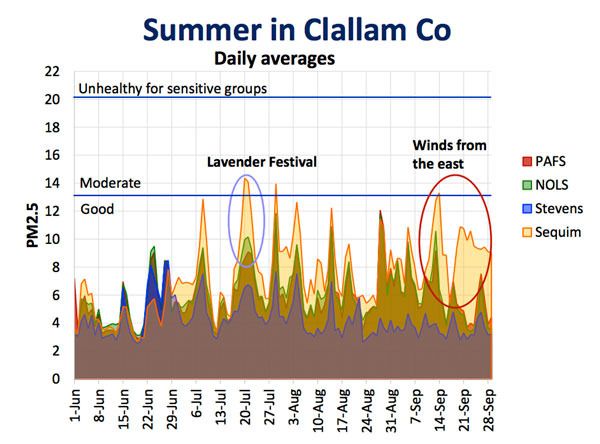Following a year-long study, officials with the Olympic Region Clean Air Agency find Sequim’s air is typically good.
“People don’t need to be too concerned,” said Odelle Hadley, air agency senior monitoring specialist.
“Generally, (Sequim’s) air quality is good.”
The ambient air study tested four sites through early April in Sequim atop the Clallam County Fire District 3’s fire station and at the Port Angeles Fire Station, Port Angeles Library and Stevens Middle School in Port Angeles.
The four optical particle counters moved to Port Townsend in May for an annual saturation study of the air agency’s six covered counties through 2018.
Hadley said following the study they determined that the permanent particulate monitor for 2.5 microns or smaller, minus ultra-fine particulates, at Stevens Middle School should move to the Port Angeles Fire Station.
“Generally, it’s most representative of all the sites,” she said. “We want to measure where would be the worst ambient air quality.”
She anticipates the permanent monitor moving between October to January following the Department of Ecology’s approval.
The demand for the saturation study in Clallam County was largely driven by concerns regarding the biomass-burning cogeneration plant at Nippon, which has been mostly shut down or under repairs since opening.
Hadley said in the time the plant was operational, the wind direction was mostly unfavorable to measure particulates and make an assessment on its air impact.
An ultra-fine particulate study that grew out of citizens’ concerns remains going through 2014.
“If they get their boiler operating, we might have to run (a study) into next summer,” Hadley said.
What about Sequim?
As for Sequim, no air agency sponsored monitors are planned for installation as a follow up to the study.
In winter and summer, Sequim reaches its highest levels of particulates at “moderate,” 13.5-20.4 micrograms of 2.5 micron particles per cubic meter of air, about 4-5 percent of the time per day on average in winter and summer.
“Both (seasons) are still considered good air,” she said.
Several variables could have come into play to raise the levels here, Hadley said, such as summer traffic particularly during Sequim Lavender Weekend and/or during construction to widen U.S. Highway 101.
“We’re unsure in the data if that summer was unique because of the highway extension and if that could be generating a lot more dust,” she said. “We do see a lot more dust and a shift to higher particulate counts.”
What surprised Hadley was learning the air quality was better in the summer than winter.
“Normally you see that flip-flopped,” she said.
The study’s highest levels of poor air quality air came Nov. 8 at the Port Angeles Library, Dec. 13-20 at the Port Angeles Fire Station and Jan. 24 at all four sites.
Sequim’s worst air quality came Jan. 24 at nearly 20 micrograms of 2.5 micron particles per cubic meter of air, which is bad for people like children and the elderly.
In the summer, Sequim’s worst air quality came around the Sequim Lavender Weekend at 14 microns, which is just over the cusp of “moderate.” It approached this level two other times last summer.
In spring, Sequim remained “good” except for stints in May around 16 microns, which Hadley said could be due to burning debris from the widening of U.S. Highway 101 project.
The biggest reasons for the low air quality, Hadley said, came from wood smoke and diesel exhaust in the winter.
To help with air quality, she recommends people replace their wood stoves with gas or certified pellet stoves. Throughout the year, Hadley also said people should consider alternatives to outdoor burning such as composting and chipping.
For more information on Clallam County’s study, go to orcaa.org, “Your Air,” “Saturation Studies,” and “Clallam County” or visit orcaa.org/air/saturation-studies/clallam-county.



